Camellias are lovely broadleaf evergreens that often make up the working backbone of a garden. There are enough different varieties to keep your garden in bloom every month of the year. This shrub is often thought of as low maintenance and suitable for even the most inexperienced gardener. There are a few insect pests that may appear on your otherwise healthy shrubs. Aphids and scale Insects are sap-sucking pests that are relatively easy to control using both mechanical and cultural techniques. Although less commonly seen on Camellias, weevils, sharpshooters, and beetles can cause significant damage to flowers and foliage. Monitoring Camellias regularly to diagnose and treat any outbreaks quickly is key to successful control.
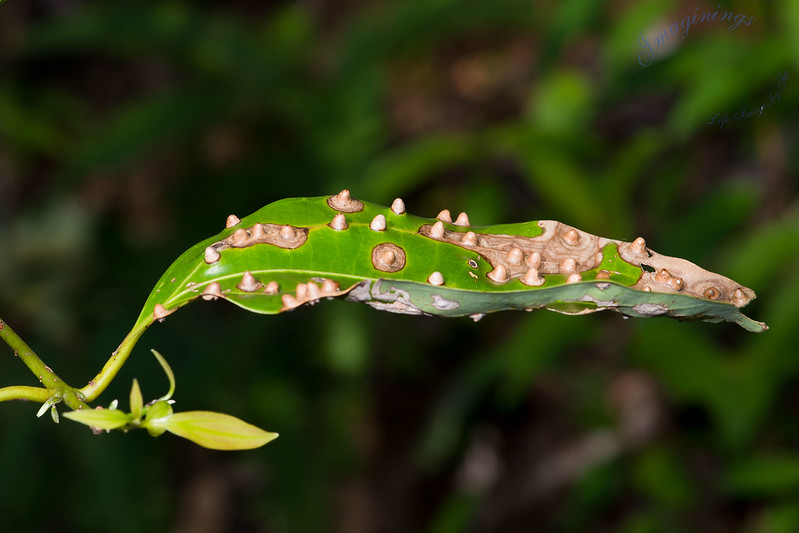
Photo by Dr Sue Jaggar
Common Camellia Pests
Aphids
Aphids are the most common pest of Camellias in many of the USDA growing zones. These sap-sucking insects are often attracted to weakened and struggling plants and can seem to appear from out of nowhere in a matter of days. Melon Aphids (Aphis gossypii), Black Citrus Aphids (Toxoptera citricida), and Green Peach Aphids (Myzus persicae) can reproduce quickly, producing many generations of aphids in one growing season. In warmer growing climates, these aphids will continue to lay eggs year-round if not managed.
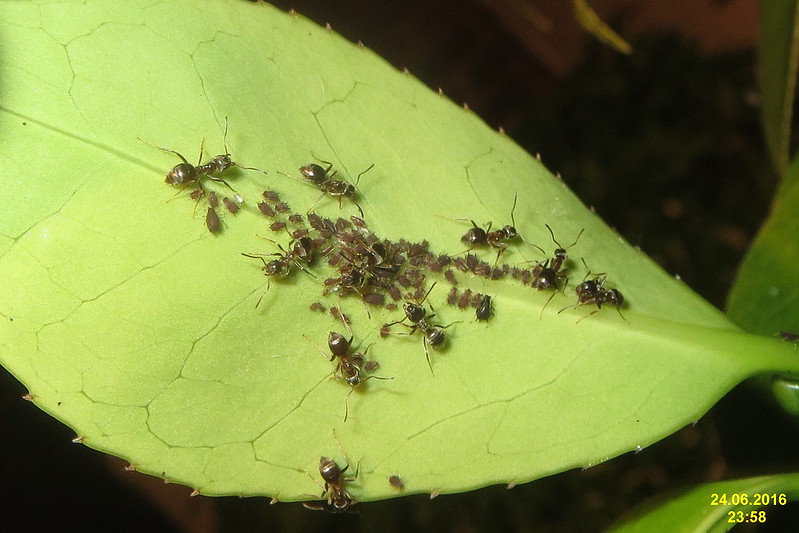
Photo by David Short, unmodified, Flickr, Copyright CC by 2.0
The young nymphs and adults get nutrition from the leaves and other soft tissue of Camellias, causing leaf distortion and bud malformation; aphids can also transmit viruses to the shrubs. Look for small green, black, or yellowish adult aphids on the undersides of leaves and in the joints of the stems. Heavy infestations will result in a sticky honeydew that is excreted by the adult insect on leaves and stems. The honeydew attracts other pests such as ants who farm the rich nectar and fungal mold spores that live in the air.
Treating Aphids on Camellias
Small infestations of aphids are often easily controlled with a sharp stream of water from a hose. Spray the undersides of leaves well to knock insects off the plant and drown any that remain. Spraying may need to be done every 2-3 days to control newly hatched nymph stages.
Insecticidal soap sprays are useful on larger outbreaks, as the soap will eat away at the soft bodies. Repeated applications may be required after periods of heavy rain or if overhead watering is used for irrigation. Cut out any badly infected stems, branches, or flower buds to not only remove the pests but to keep the Camellia looking healthy and clean. Any foliage that is affected by honeydew will need to be removed to prevent further infection from sooty mold.
Preventing Aphids on Camellias
The best way to prevent aphids on Camellias is to provide the shrubs with at least 6 hours of sun exposure and plenty of good air circulation. Thin out dense overgrown parts of the Camellia to improve airflow around the plant. Deadheading after the flowering period will remove any aphid eggs before they can overwinter.
Do not use broad-spectrum pesticides or herbicides in the garden. These sprays and granular formulas not only kill off pests, but also damage and kill beneficial pollinators and predators in your garden. Encourage beneficial predators such as lady beetles, lacewings and syrphid flies to live and feed in your yard by providing areas for them to overwinter and lay eggs for future generations. Gardens dedicated to pollinators or areas left ‘wild’ on purpose in the garden are ideal habitats for beneficial insects and other wildlife to live and create a balanced ecosystem with pests.
Scale Insects
Camellias often suffer from scale insect damage, especially in warmer climates that rarely experience freezing temperatures in the winter. These insects are sap-suckers that attach themselves to stems and the base of leaves, feeding in one location after hatching. Their shield-shaped exoskeleton protects them from natural predators.
Two types of scale insects affect Camellias: Armored Scale and Soft-bodied Scale. Armored Scale have a tough shield and are difficult to remove after they attach. Soft-bodied Scale do not have a hard shell and can be easily squished and scraped off stems, although they tend to deposit themselves in hard-to-reach areas of the shrub. Soft-bodied Scale are more likely to form a sticky honeydew, which can cause secondary problems such as an ant infestation and unwanted residue on foundations of buildings or cars parked near the shrub. Damage from Scale insects ranges from shriveled leaves and flower buds to desiccation of whole branches.
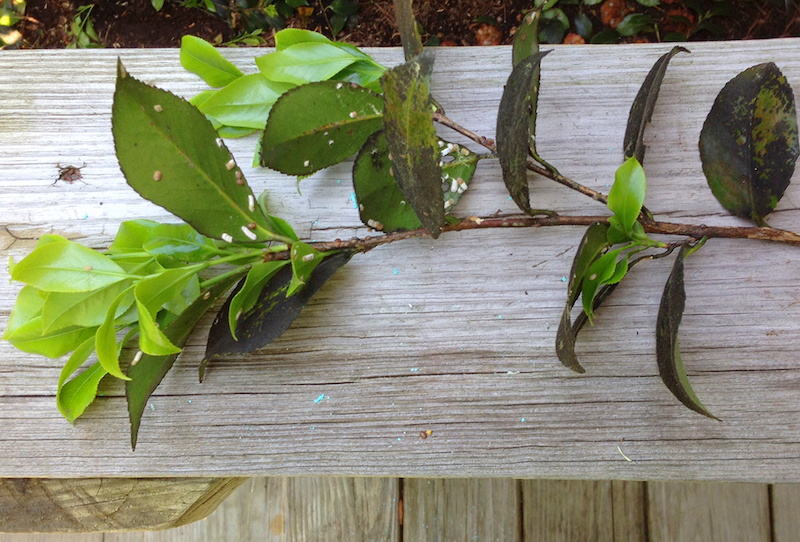
Photo courtesy of James Baker, NC State University
Treating Scale on Camellias
Scale can be difficult to treat not only due to their wax covering, but also because the insects are good at hiding in the foliage. If the outbreak is caught early and is still small, mechanically squishing the scales will be enough to get rid of the pest. Wipe any soft bodies and remaining shields off the plant with a rag or towel. If outbreaks become routine from season to season, you can spray with NEEM oil, or other horticultural oil with an ORMI certification, in late winter before blooming. Sometimes outbreaks of scale on Camellias cannot be controlled sufficiently, and removing the plant may be the only option to protect surrounding plants and property.
Preventing Scale on Camellias
Monitoring Camellias is the best way to prevent a large infestation of scale insects. Early treatment often results in complete recovery of the shrub. Check for the oval-shaped scales on stems, leave nodes, and at the base of flower buds. Also, keep an eye out for large numbers of ants coming and going near your Camellia. This could indicate they are farming the honeydew exuded by scale.
Encourage natural predators such as lacewings, lady beetles, and parasitic wasps that lay eggs in the scale insects. These predators keep pest populations to low, manageable levels. Prune out any portion of the shrub that has been severely damaged to get rid of any eggs that might have been laid. Regular pruning and deadheading of Camellias helps them stay healthy and more resistant to pests.
Camellia Bud Mites
Even though Camellia Bud Mites (Eryiophids) are one-third the size of spider mites, they cause the most visible damage to Camellias. These tiny mites, impossible to see without magnification, feed inside the many layers of Camellia petals and cause the flowers to either not open or to drop off the plant still in the bud stage. These mites overwinter in the forming buds of Camellias. and emerge as the weather warms in spring to lay eggs.
The newly hatched nymphs are able to move from plant to plant by wind, birds feeding or nesting in the shrub, or gardening tools used to prune out infected plant material. Affected buds will turn brown and wither, eventually falling off the plant. Buds at the tips of the stems will be affected first, with damage eventually running down the stem toward the main branches.
Treating Camellia Bud Mites
Because Bud Mites are so tiny and can safely live in the tiniest nooks and crannies of your Camellia, using a contact pesticide is of little use. Systemic pesticides may be useful for hard-to-control outbreaks, but the chemicals in these broad-spectrum formulas also damage beneficial insects around your garden. Mechanical control at the first sign of flower bud browning is the main, and safest, method to control Bud Mites. Removing the affected buds early gives the Camellia a chance to produce more flowers, and disrupts the life cycle of the Bud Mites.
Preventing Camellia Bud Mites
Good garden hygiene is imperative to preventing the spread or continuation of infestations of Camellia Bud Mites. Dispose of any pruned or fallen flower buds with signs of damage. Do not compost infected plant material in a home compost pile. Mulch under affected plants should also be disposed of and replaced with fresh material as soon as the outbreak has been controlled. Camellia Bud Mite thrives in periods of hot and dry weather and will attack plants that are dehydrated or planted in too much sun. Camellias prefer rich, moist soil on the acidic side. Camellias growing in USDA zones 9-10 will benefit from shade during the hottest time of the day to prevent sunscald on the leaves and flower buds.
Fuller Rose Beetle
Rose Beetles are weevils that live on a wide variety of woody plant hosts. The Fuller Rose Beetle adult is large (3/8-inch long) and dark colored, with large eyes. In the larval stage, it lives at the base of the shrub, eating at the roots and woody tissue of the bark. The adults move up into the shrub to chew on the margins of leaves, leaving ragged and tattered edges. Most often in Camellias, the beetle will destroy the flowers either while still in bud or after opening. Small infestations are not generally a cause for concern, although plants that are routinely attacked over the years can decline in health and growing vigor.
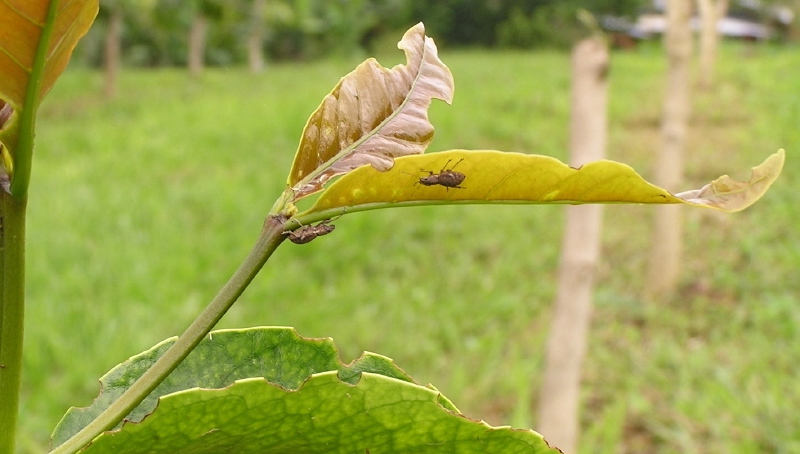
Photo by Scot Nelson
Treating Fuller Rose Beetle on Camellias
The easiest way to treat Fuller Rose Beetles is to disrupt their life cycle by trapping the adults as they pupate and start to climb into the shrub. Wrap a thin piece of cardboard around the base of the main Camellia stem. Smear a layer of Tanglefoot or similar sticky insect-trapping ointment. When the adults attempt their nightly climb into the Camellia, they will get firmly stuck and eventually die. The trap may be replaced as often as needed to get the populations under control.
Preventing Fuller Rose Beetle on Camellias
Good garden hygiene at the end of the growing season is important for removing any eggs in mulch or fallen plant debris. Pick adults off the plant and place them in a bucket of soapy water. Keep branches trimmed up so they do not touch the sides of buildings or foundations, allowing the adults to climb into the shrub's canopy.
Black Vine Weevil
Black Vine Weevil can be a serious nuisance for Camellias. The larval stage feeds mainly on the root area at the base of the shrub, weakening the plant and causing an entry point for fungal diseases. The adults are mobile and can walk from plant to plant. Most often, the only visible damage is from feeding adults that eat the margins of foliage. If the adults emerge during budding, they will feed extensively on the buds, resulting in less flowering.
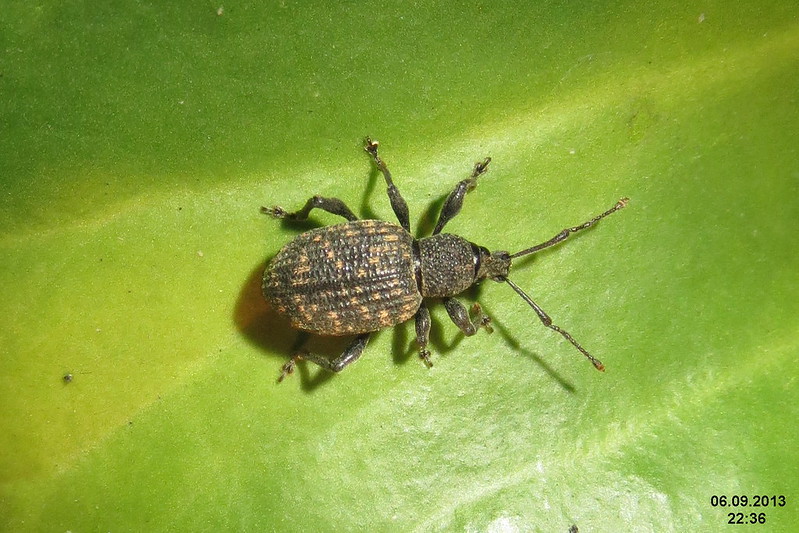
Photo by David Short, unmodified, Flickr, Copyright CC by 2.0
Treating Black Vine Weevil on Camellias
Hand-pick any adults that can be seen eating foliage or flowers. Early evening is a good time to catch most of the adults as they move into the shrub to eat. Wrapping a band of cardboard smeared with Tanglefoot is a great way to trap as many adults as possible. The band can be replaced as many times as needed throughout the season to disrupt the life cycle and prevent more eggs from being laid for future generations.
Preventing Black Vine Weevil on Camellias
Remove any fallen foliage or flowers to prevent eggs from overwintering near your Camellias. Dispose of the material in the trash or burn it. Do not put infected plant material in your compost pile. Home compost piles rarely reach the temperatures needed to kill off pathogens or pests, increasing the likelihood of spreading Black Vine Weevils to other susceptible plants. Prune the lower branches of the Camellia so that none touch the ground and provide easy access for adult weevils to reach the canopy.
Glassy Winged Sharpshooter
Glassy Winged Sharpshooters typically do not do much damage to Camellias with their sap-sucking alone. These are Leafhopper insects that can easily fly between plants, feeding on the sap of the evergreen foliage. The real threat to the plant is transmission of a virus by the Sharpshooters. Signs of Sharpshooter damage include stippling of the leaves, browning, and leaf drop. Plants that are infected with a virus may not show symptoms for a season or more. Often the plant’s health will slowly decline, resulting in part or all of the shrub dying back. The virus is called Pierce’s Disease and causes leaf scorch on a range of broadleaf evergreen shrubs such as Camellias and Oleander.
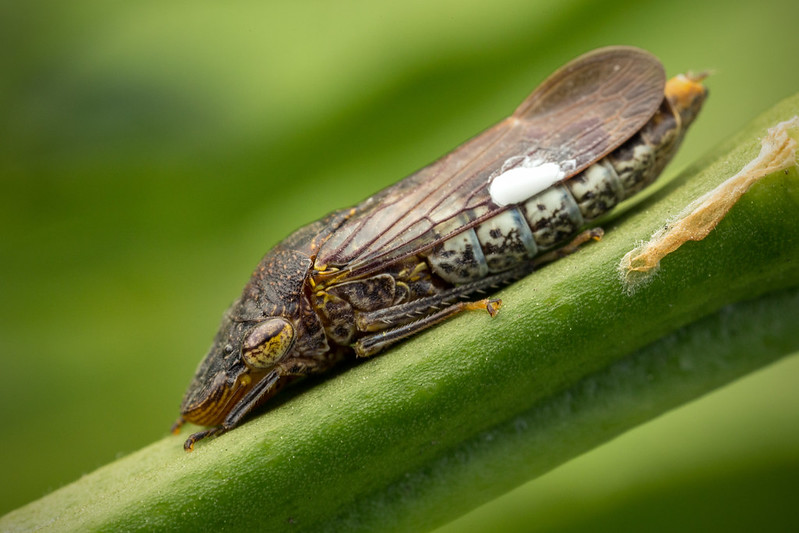
Treating Glassy Winged Sharpshooter on Camellias
Detection and mechanical management are the two safest means of controlling Glassy Winged Sharpshooter. Detecting the insect is difficult because its clear wings and body blend in with the branches and stems of the Camellia. Hanging yellow sticky traps on a branch will alert you to this insect’s presence before damage can be done. Cut out any plant material with severe damage or honeydew coating it. If this insect is detected in your garden, consult with your county Extension or Master Gardener program to determine if reporting the infestation is required.
Preventing Glassy winged Sharpshooter on Camellias
There are many predatory insects and arachnids that feed on Glassy Winged Sharpshooters, including lacewings, spiders of all types, assassin bugs, and mantids. Healthy populations of predators will keep pests to a low number, resulting in far less plant damage. Use mechanical and cultural means of pest control instead of spraying broad-spectrum insecticides. Such organic practices keep the beneficial insects in your garden safe while allowing for a natural balance between predator and prey.
Sources:
"Camellia Diseases and Insect Pests." Clemson University Cooperative Extension Service. hgic.clemson.edu
"Camellia Pests and Problems." University of Florida / IFAS. gardeningsolutions.ifas.ufl.edu
 |
Author Robbin Small - Published 7-31-2023 |
